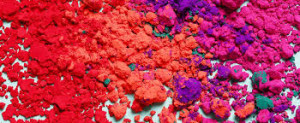
Pigments are intensely coloured loose powders that are present in a big way in the cosmetic industry. They are being used as a basic ingredient while preparing the varied make-up products used to beautify a woman. You will find that pigment blue, pigment green, pigment yellow and pigment orange are commonly used colours for eye-makeup whereas shades of pigment red are used more for highlighting a woman’s cheekbones. Pigments can be matty or they can be shimmery; both options are being offered through the resulting products for choice to the woman.
What are the types of pigments that go into the cosmetic industry? Both the inorganic as well as the organic pigments are being used for manufacturing make-up products. The most popularly used inorganic pigments include the iron oxides, chromium oxide, titanium oxide, ultramarines etc. Ultramarines are responsible for making available the metallic hues of blue that are often prevalent in eye makeup. Chromium oxide gives the green hues used in several shades of eye makeup.
Iron oxides are more used in the manufacture of day-time make up products as it includes pigment yellow, pigment red and other vibrant shades in its fold. Titanium oxide provides the much needed UV shield to some extent and therefore becomes an important ingredient in the manufacture. The solvent resistance and opaqueness of inorganic pigments make them a must include ingredient in the manufacture of make-up products.
Organic pigments on the other hand vary from inorganic pigments from the solubility point of view; they are soluble in a number of solvents. The kind of organic pigments that form the base of raw materials in the cosmetic industry include the likes of Xanthenes, Azo colorants, Triaylmethane and Anthraquinone.
Each of them lend varying grades of shades that are needed to manufacture different skin friendly make-up products. The Azo colorants give the bright yellow and red shades while the base for the soothing blue and green shades come from Triarylmethane. Vibrant orange and red are obtained from Xanthenes which is considered a staining dye. Anthraquinones refer to a group of naturally occurring pigment that gives the much used green colour in the cosmetic industry.
However, the manufacture of make-up products using the various pigments is a very complex one. There are several rules and regulations laid down by FDA with regard to colour additives that are being used in the cosmetic industry. Every make-up product containing colour additive has to meet requirements for approval, certification, identity and specifications, permissible concentrations etc. Colours that need certification are mainly petroleum derived or synthetic-organic colours.
Every batch of the cosmetic using these colour ingredients have to be FDA-certified. Certain colour additives such as those originating from plant, mineral and animal sources do not require batch certification requirements. However, they have to adhere to the specifications, identity, restrictions, uses and labelling requirements as specified under the rules. If the rules and regulations with regard to colour additives are not complied with, then your cosmetic will be declared as adulterated. So it is better to make use of the pigment raw materials in the best and right manner possible so as to deliver the best quality from your cosmetic industry!